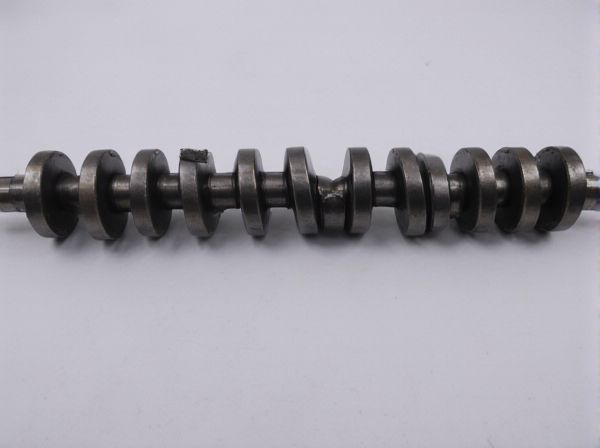
Photo illustration: Stroker crankshaft vs Stock stroke crankshaft
A stroker crankshaft increases engine displacement by extending the piston stroke, delivering more torque and horsepower compared to a stock stroke crankshaft. This modification enhances performance and engine responsiveness, ideal for enthusiasts seeking improved power output. Your choice depends on the desired balance between engine longevity and performance gains.
Table of Comparison
| Feature | Stroker Crankshaft | Stock Stroke Crankshaft |
|---|---|---|
| Stroke Length | Increased stroke for higher displacement | Original factory stroke length |
| Engine Displacement | Higher displacement, boosts torque | Stock displacement, balanced performance |
| Torque Output | Significantly increased torque | Standard torque output |
| RPM Range | Lower max RPM due to longer stroke | Higher RPM ceiling, suitable for high revving |
| Engine Stress | More stress on engine components | Less stress, better longevity |
| Installation Complexity | Requires custom machining and tuning | Direct bolt-in with minimal modifications |
| Use Case | Performance builds focused on torque and displacement | Daily drivers and stock performance maintenance |
Introduction to Crankshafts
Crankshafts convert the linear motion of pistons into rotational motion to power the vehicle's drivetrain. A stock stroke crankshaft maintains the original piston stroke length designed by the manufacturer, ensuring factory performance and reliability. In contrast, a stroker crankshaft increases the piston stroke, enhancing engine displacement and torque output for improved power and acceleration.
What is a Stock Stroke Crankshaft?
A stock stroke crankshaft refers to the original crankshaft design manufactured for an engine, maintaining the factory's specified stroke length that determines the piston travel within the cylinder. This standard stroke length preserves engine reliability, balance, and efficiency as intended in the original engine configuration. Stock stroke crankshafts are commonly used in routine maintenance and engine rebuilds to ensure optimal performance without altering the engine's displacement or mechanical characteristics.
Understanding Stroker Crankshafts
Stroker crankshafts increase engine displacement by extending the stroke length beyond the factory stock specifications, boosting torque and horsepower significantly. Using a stroker crankshaft alters the piston travel distance within the cylinder, resulting in greater combustion volume and improved engine performance, especially in muscle cars and racing applications. Unlike stock stroke crankshafts that maintain OEM dimensions for reliability and predictability, stroker versions require precise engineering to balance durability with enhanced power output.
Key Differences: Stroker vs Stock Stroke
A stroker crankshaft increases engine displacement by lengthening the stroke, resulting in higher torque and horsepower compared to a stock stroke crankshaft, which maintains the original factory stroke length for balanced performance and reliability. Key differences include the stroker's ability to boost engine output through increased piston travel, while a stock stroke crankshaft prioritizes durability and compatibility with existing engine components. The choice between stroker and stock stroke crankshafts depends on performance goals, with stroker setups favored for racing and high-power applications, and stock stroke preferred for everyday driving and longevity.
Performance Benefits of Stroker Crankshafts
A stroker crankshaft increases engine displacement by extending the piston stroke, resulting in higher torque and improved low-end power compared to a stock stroke crankshaft. This increased swept volume enhances combustion efficiency and horsepower output, making it ideal for performance applications and muscle cars. Stroker crankshafts also improve engine durability under high stress by reducing peak RPM demands while delivering stronger acceleration and throttle response.
Power and Torque Comparison
A stroker crankshaft increases engine displacement by lengthening the piston stroke, resulting in higher torque output at lower RPMs compared to a stock stroke crankshaft. Enhanced piston travel allows for improved combustion efficiency and greater power generation across the torque curve. While the stock stroke crankshaft maintains factory dimensions, it provides balanced power and reliability but lacks the torque gains seen in stroker configurations.
Engine Durability Considerations
Stroker crankshafts increase engine displacement by lengthening the stroke, which generates higher torque and power but also imposes greater stress on internal components such as connecting rods, pistons, and bearings. Stock stroke crankshafts maintain original design parameters prioritizing balanced load distribution and longevity, reducing the risk of premature wear and failure under typical operating conditions. Engine durability with stroker crankshafts often requires upgraded components and reinforced engine blocks to handle increased mechanical forces and thermal loads.
Applications: Street vs Racing
Stroker crankshafts increase engine displacement by extending the piston stroke, enhancing torque and power output, making them ideal for high-performance racing applications where maximum power and acceleration are critical. Stock stroke crankshafts maintain factory bore and stroke dimensions, providing a balance of reliability, fuel efficiency, and longevity suited for everyday street driving and moderate performance upgrades. Racing engines benefit from stroker cranks due to improved combustion efficiency and higher rev limits, while street engines prioritize durability and smoother operation with stock stroke setups.
Cost Implications and Investment
Stroker crankshafts typically require a higher initial investment due to their specialized design and the need for compatible engine components, raising overall build costs compared to stock stroke crankshafts. Although stroker setups can enhance engine displacement and performance, the cost implications include not only the crankshaft itself but also potential upgrades to pistons, rods, and machining services. Stock stroke crankshafts offer a more budget-friendly option with lower upfront costs and reduced modification expenses, making them suitable for cost-conscious engine builds or stock replacement scenarios.
Which Crankshaft is Right for You?
Choosing between a stroker crankshaft and a stock stroke crankshaft depends on your performance goals and engine application. A stroker crankshaft increases engine displacement by lengthening the stroke, delivering higher torque and horsepower, ideal for drag racing or heavy-duty builds. Stock stroke crankshafts maintain factory dimensions for reliability and smoother operation, perfect for daily driving or moderate performance upgrades.
 caratoz.com
caratoz.com